
Unknown maker, Phulkari early 20th-century (detail), Cotton with floss silk embroidery. © Bradford Museums and Galleries. Photo: Paul Tucker.
Two Temple Place, London
25 January – 19 April 2020
by BETH WILLIAMSON
There is something about the concept behind this exhibition that makes it special. As the formats of the chronological survey, the period-specific and the medium-specific exhibition grow somewhat weary, this exhibition takes the textile collections of seven pioneering women and exhibits them in the Gothic revival building at Two Temple Place in London to add depth to a history of textiles that is, even now, neglected. That these collections are now notable and some of the most diverse and global public collections in the UK today makes it all the more significant.

Edith Durham, Object labels, Pen, pencil on paper. © Calderdale Museums Collection, Halifax. Photo: Paul Tucker.
While there is a chronology to the 100 years this exhibition covers, it is at times disrupted and it does not restrict the objects, each with their own context, often the endeavour of a single hand, but at times a collaborative effort that is all the more captivating for that. Objects have been carefully selected to show the richness of the women’s collections, their constraints (financial and institutional) and their creativity and passion in growing unique collections of textiles that tell new stories of our social and cultural histories.
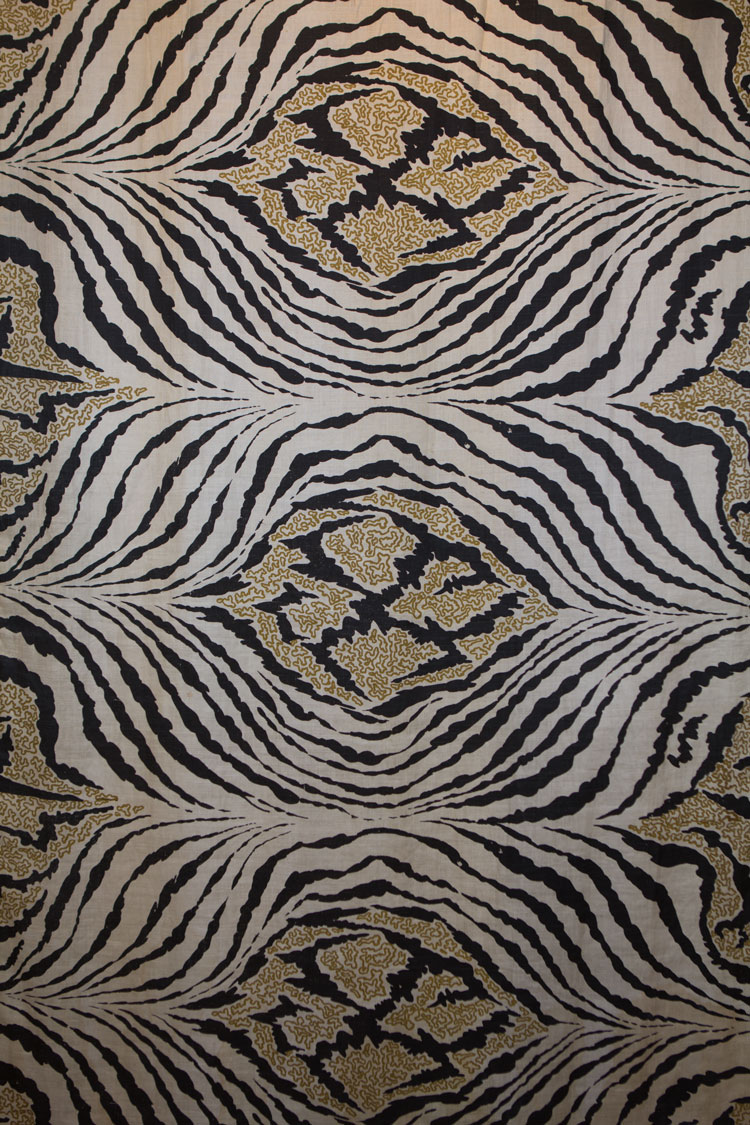
Enid Marx, Curtain with Jungle Repeat Pattern, date unknown. Printed undyed linen. © Compton Verney. Photo: Harminder Judge.
The seven women concerned are: the artist, anthropologist and writer Edith Durham (1863-1944); the scholar, educator and practitioner of embroidery Louisa Pesel (1870-1947); the collector Olive Matthews (1887-1979); the painter and designer Enid Marx (1902-98); Muriel Rose (1897-1986), a gallerist and a founder of the Crafts Study Centre; Jennifer Harris, who worked at the Whitworth, University of Manchester, from 1982 to 2016; and Nima Poovaya-Smith, the senior keeper of international arts at Cartwright Hall Art Gallery, Bradford, from 1985 to 1998. There are many reasons behind these women’s collecting. Apart from the obvious differences of some of the collections beginning life as private or public collections, the women, passionate in their collecting, were sometimes professionals, too. The kinds of materials collected varied greatly from anthropological objects to dress, craft and design to art and culture, historic artefacts to contemporary art practice. All these facets are represented in this exhibition.
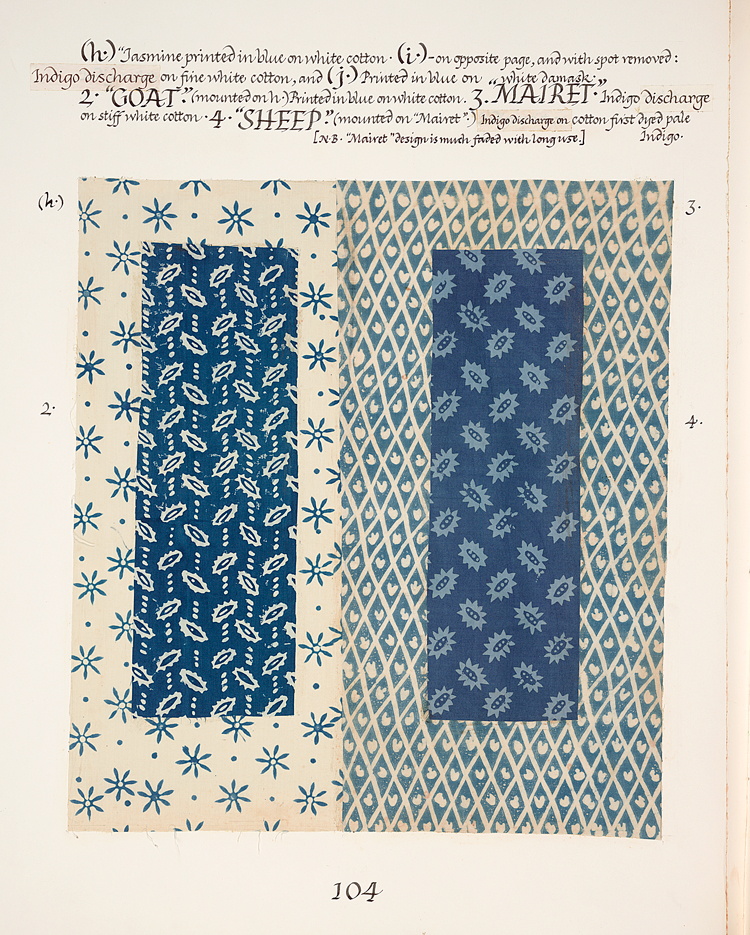
Robert Tanner, Duplicate sample book showing ‘Jasmine’, ‘Goat’, ‘Mairet’ and ‘Sheep’, 1970s. Block print on cotton in book. © Crafts Study Centre/Crafts Study Centre 2004 .
The exhibition begins in the lower gallery with items from the collections of Durham, Pesel and Matthews. One exception to this is the inclusion early on of The Subversive Stitch Sampler (1988) by Lyn Malcolm. This marks two related exhibitions of that year curated by Jennifer Harris in Manchester and responding to Rozsika Parker’s seminal text The Subversive Stitch: Embroidery and the Making of the Feminine, first published in 1984. The relationship between textiles and femininity, and challenging such stereotypes, is key in this exhibition, too.
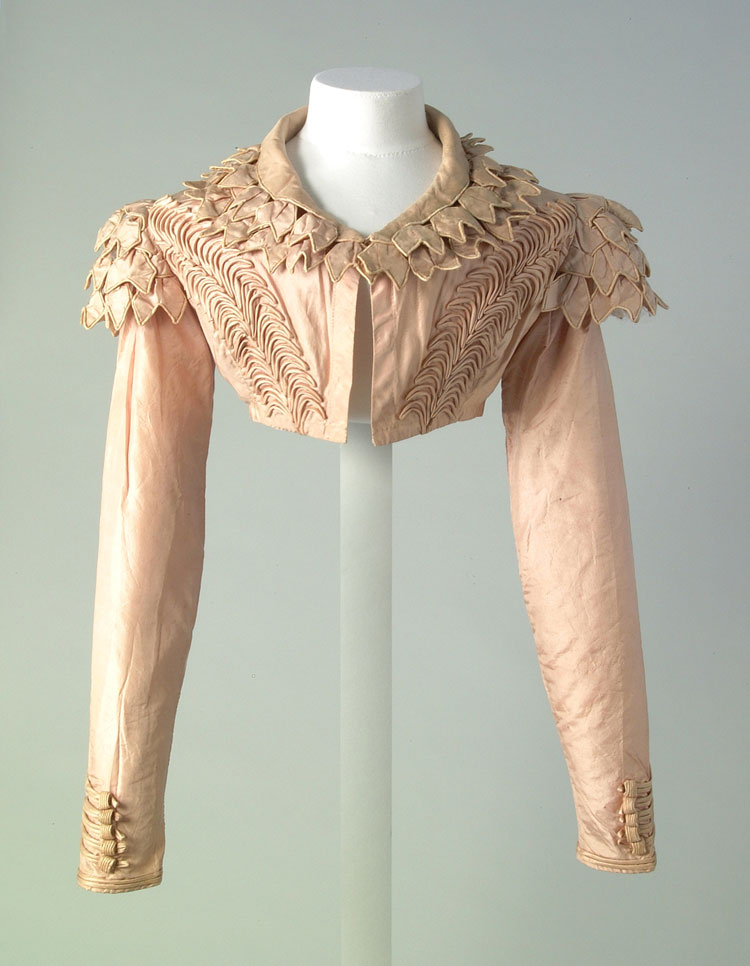
Spencer, 1817-19. Silk, cotton lining. © The Olive Matthews Collection, Chertsey Museum. Photo: John Chase Photography.
Durham, Pesel and Matthews all reached adulthood in the Victorian era. Matthews began collecting at the age of 12 and continued for 40 years. Restricted by her self-imposed budget, but freed up by her interest in unfashionable material, she amassed a collection of historical costume largely from the period 1740-1840. With an eye for quality and technically accomplished objects, she amassed a collection of about 3,000 items by the time she decided to donate it to Chertsey Museum in 1969. It contains exquisite objects such as a 16th-century brocade shoe with clog and a 17th-century silk and cotton spencer, or short jacket.
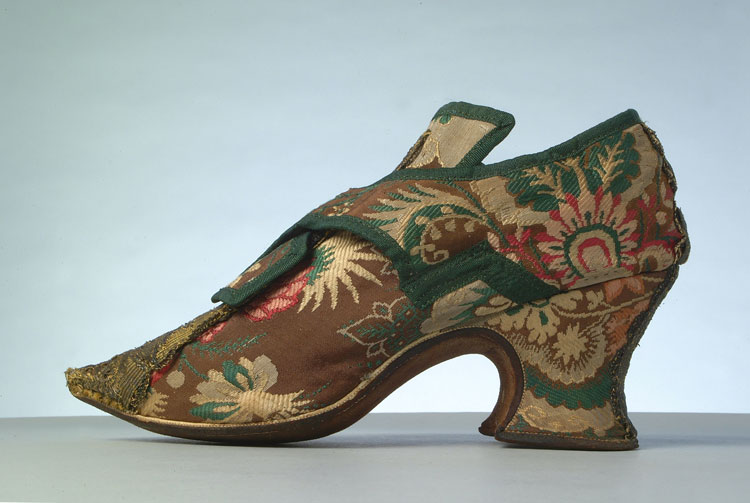
Brocade Shoe without Clog, 1735-45. Brocaded silk. © The Olive Matthews Collection, Chertsey Museum. Photo: John Chase Photography.
Durham’s interests were rather different and focused entirely on the material culture of the Balkans. Her notes, photographs and sketches add considerably to her collection of textiles. The ethnic cleansing of Balkan museums in the 1980s and 90s make Durham’s collection all the more significant now. Pesel collected fragments of textile that could be viewed from front and back to see how stitches were worked. Included is a Winchester Cathedral design sampler (1934-36). With the artist Sybil Blunt, Pesel developed a project at the cathedral. Between 1931 and 1936 hundreds of volunteers made kneelers, stall cushions, long-bench cushions and alms bags, which remain in use. Pesel’s project is the basis of the author Tracey Chevalier’s novel A Single Thread (2019).
-T2009.10.9,-Mr-Hiroyuki-Shindo-DETAIL-1.jpg)
Hiroyuki Shindo, Shindigo Space 2007. Dyed hemp, cotton, polystyrene. © The Artist. Courtesy of the Whitworth, The University of Manchester.
In the stairwell at Two Temple Place, the carved mahogany staircase acts as a repository containing Hiroyuki Shindo’s Shindigo Space (2007). Made from dyed hemp, cotton and polystyrene, a series of cloth banners hang loosely in the space. Beneath them, multiple spheres in different sizes are scattered across a floor of marble, jasper, porphyry and onyx, and the adjacent fireplace. It is the perfect space for this work and, as you climb the stairs, it seems to rise with you. I really liked the inclusion of handling samples, allowing me to experience the feel of the fabric and the weight of the spheres. Never have I experienced colour in such an all-encompassing fashion.
Upstairs, the library contains items from the collections of Rose and Marx. These two were key figures in the field of 20th-century craft and design. It was during the interwar period when women became more independent, that Rose and Marx developed their respective careers. Rose established the Little Gallery with Margaret Turnbull and exhibited modern textiles in solo and group exhibitions from 1928 to 1939. She included quilts, embroidery, weaving and rugs. She also showed contemporary ceramics and craft processes such as weaving and printing. I particularly appreciated seeing related ephemera – exhibition invitations, business cards and booklets. Marx was a designer and collector and her collecting interest informed her designs. For instance, we can see her childhood interest in collecting silk ribbons reflected in her printed silk ties (1920-30). It is not difficult to imagine pieces such as the Curtain with Jungle Repeat pattern shown in this exhibition hanging in Marx’s home.
In the Great Hall, it is the collections developed by Harris and Poovaya-Smith that feature. As contemporary curators and academics, Harris and Poovaya-Smith held important institutional sway and are credited with important collections. Harris’s collecting recorded shifts in contemporary practice. When she joined the Whitworth, she inherited work such as Polish-born Tadek Beutlich’s fibre work Reflection of the Moon (1977) and used that as a context to build the collection. Alice Kettle’s contemporary machine-embroidered work Three Caryatids (1988-89) was one of the first major works Harris acquired for the Whitworth. Kettle’s work looks stunning hung in the Great Hall.
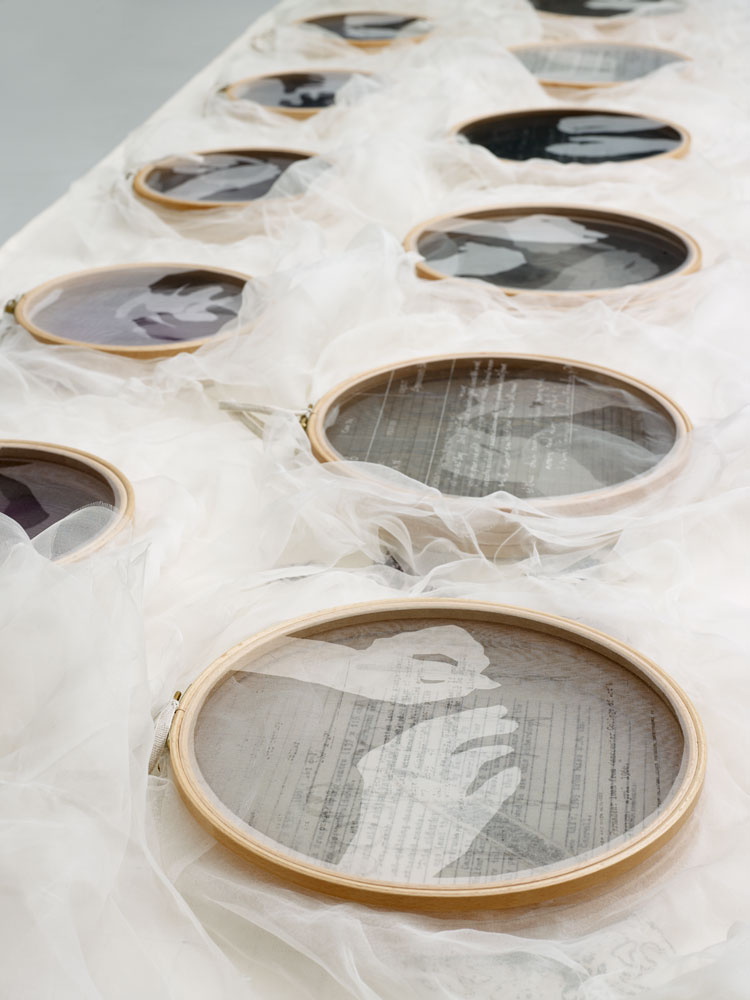
Caroline Bartlett, Conversation Pieces 2003. Embroidery hoops with printed and stitched fabric. © The Artist. Courtesy of the Whitworth, The University of Manchester.
Caroline Bartlett’s installation Conversation Pieces (2003) is captivating for many reasons. It was commissioned by the Whitworth and made in response to the gallery’s textiles collection and those who work with it. The very idea of conversation seems important to me as, quite unusually, strangers were talking to one another in this exhibition. Perhaps the intimate nature of textiles and the exhibition space invited conversation. Conversation Pieces is an installation of embroidery hoops. The edges of the hoops are inscribed with collector’s terms: “edges partly worn”, “signs of foxing”, “provenance unknown”, for instance. The layering of printed and stitched translucent fabric within the hoops brings together image, word and stitch so that stitching itself becomes a conversation. The hands and undertakings of conservators at work are interwoven with those of textiles artists.
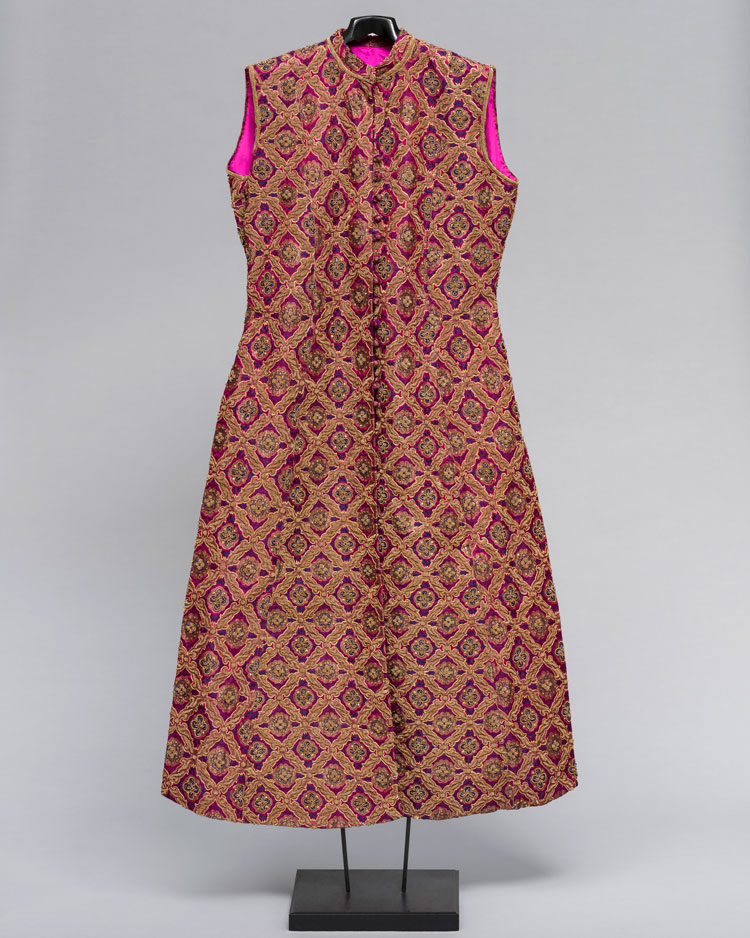
Sehyr Saigol (designed by), Zardosi Robe, 1994. Brocaded silk with zardosi, sequin and beadwork embroidery. © Bradford Museums and Galleries. Photo: Paul Tucker.
Poovaya-Smith’s collecting responded to historic and contemporary cultural diversity in the UK. While at Cartwright Hall Art Gallery, she grew the textiles collection from just a dozen objects to almost 2,000. It is significant in its holdings of contemporary art by artists of South Asian, African and Caribbean heritage. It investigates important questions of cultural identity and appropriation motivated by the diverse communities of Bradford. Early 20th-century embroidery pieces jostle with clothing items such as Sehyr Saigol’s Zardosi Robe (1994) brocaded in silk. Alongside the gold adornments of contemporary saris by Fahmida Shah and Sarbjit Natt sits Yinka Shonibare’s The Wanderer (2006-7), a wooden model of a ship with wax printed cotton sails.
Nina Edge’s Zero (1992), commissioned by Poovaya-Smith, is a fitting end-piece to the exhibition. In Zero, Edge creates contemporary art using batik on cotton and traditional dying techniques. It asks us to reflect, perhaps to contemplate, on what we have seen and what textiles can be.
What emerges from this exhibition is just how important collections such as these are. The examples of Durham, Pesel, Matthews, Rose, Marx, Harris and Poovaya-Smith are emblematic of how the nature of collections shapes the stories they tell. Their existence in regional galleries is entirely appropriate and in keeping with the nature of their formation. Bringing them to Two Temple Place is a reminder to look beyond London and beyond the edges of what we might think of as art for new narratives, fresh voices and alternative histories of collecting.